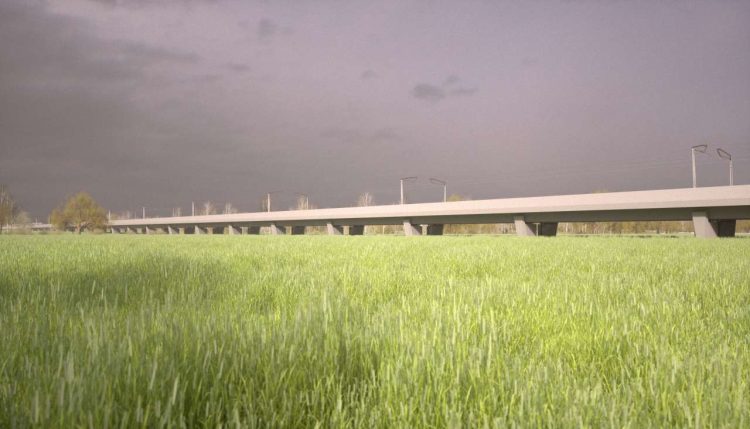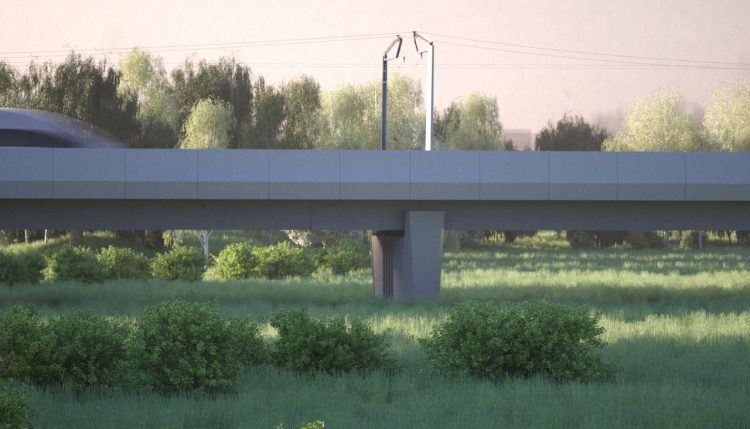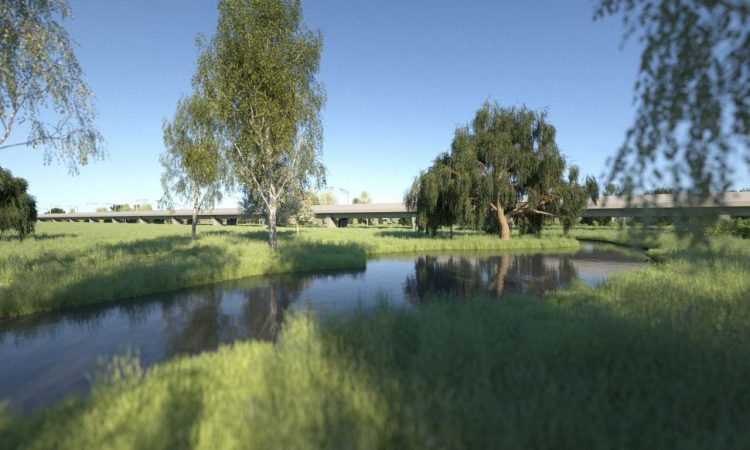The final designs have been revealed for HS2‘s Thame Valley Viaduct which crosses the flood plain of the River Thame just outside Aylesbury in Buckinghamshire.
The 880 metre-long viaduct will be constructed like a giant Lego set. Pre-fabricated sections will be slotted together, in a method that will cut its carbon footprint by an estimated 66%. When complete, the viaduct will carry HS2 trains between London, Birmingham, and the North at speeds of up to 360km/h.

Set low into the landscape with a simple and consistent profile, thirty-six 25 m long spans will cross the river and surrounding wetlands, with the underside of the viaduct just 3 m above the ground.
The concrete piers that support the viaduct will be entirely made off-site. They will be extended to almost connect with the parapet edge, helping to enhance the appearance of the structure.

In a major step forward for viaduct design in the UK, the team opted for two wide box-girder beams per span instead of eight smaller beams to simplify and speed up assembly. Production of steel and concrete is a major contributor to carbon emissions; the new lighter-weight structure is expected to save 19,000 tonnes of embedded carbon in comparison to the previous design.
As well as cutting embedded carbon in terms of materials, this approach requires fewer lorries to deliver material to site, cuts waste, and will reduce disruption for the community during construction.
Thame Valley is one of 15 viaducts designed by HS2 Ltd’s main works contractor, EKFB – a team made up of Eiffage, Kier, Ferrovial Construction and BAM Nuttall – working with their design partner, ASC (a joint venture between Arcadis Setec and COWI) and specialist architects Moxon.

Welcoming the new design, Tomas Garcia, HS2 Ltd’s Head of Civil Structures said: “HS2 trains and stations will be zero carbon from day one, providing a cleaner, greener way to travel and helping the fight against climate change.
“But we’re also serious about reducing the amount of carbon we use during construction, and Thame Valley is a great example of how our contractors are using the latest engineering techniques to do just that. Prefabrication and off site manufacturing offer huge benefits in terms of efficiency and this design will help us deliver a more efficient, durable and elegant structure with less concrete and steel.”
EKFBs Technical Director, Janice McKenna said: Cutting carbon during construction is a priority for EKFB as the team commences the building works of some of the main structures along its 80km section of HS2, and this process starts right at the initial design stages.
“Working alongside our design partners, we have tackled the carbon challenge from two angles. The structurally efficient solution means we minimise the embedded carbon in the viaduct materials; and we have also been able to reduce emissions during construction by maximising off-site pre-fabrication to achieve an efficient build, as well as reducing the number of HGVs on local roads. The techniques used in the Thame Valley Viaduct are also being used in other structures along our line of route.”
Describing the new design, Ben Addy, Managing Director of Moxon, said: “The Thame Valley Viaduct has been conceived as a minimalist elevated causeway passing low over the flood plain of the River Thame.
“This approach relies upon refinement of detail and has been enabled by the advanced engineering and construction techniques developed by the team. The result is a low key and elegant sequence of spans punctuated by thirty-four pairs of piers cradling the deck.”





Responses
It would produce an even bigger carbon saving if it wasn’t built.
Have they taken into account the carbon footprint of making the bridge sections off site. The bringing them to site. Plus the construction of then removal of the temporary roads used during the construction of the bridge. Finally all construction of all the special equipment required?
It will not be a reduced carbon when the trains are in use over 350km/h it means that our power stations will have to work harder it produces more CO2!